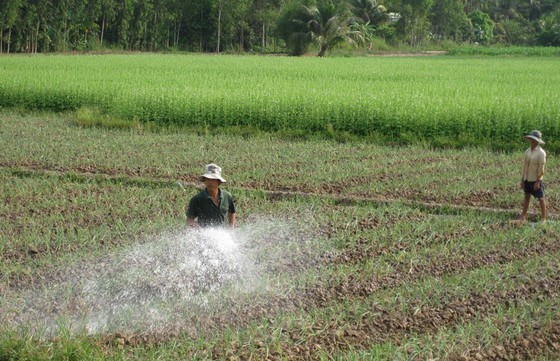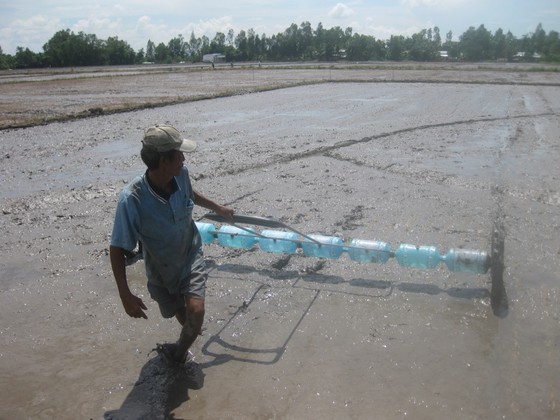
According to the Department of Plant Production under the Ministry of Agriculture and Rural Development, there were around 722,000 hectares of rice in this autumn-winter rice crop in the Mekong Delta, a decrease of 9,800 hectares compared to the same period last year and 27,700 percent in comparison with the plan. Production of this autumn-winter rice crop was estimated at 3.9 million tons, down 38,900 tons over the same period last year.
Meanwhile, there were 270,000 hectares of seasonal rice in provinces in the Southeast region and the Mekong Delta, down 27,800 hectares. Production of seasonal rice crop was expected to be at 1.29 million tons, down 115,900 tons compared to last year.
Therefore, this year, the Southeast region and the Mekong Delta of Vietnam has produced rice on total area of around 4.3 million hectares, down 41,000 hectares, with production estimated at 25.7 million tons, reducing 197,900 tons compared to last year.
The department explained that the area of rice in the Southeast region and the Mekong Delta of Vietnam dropped by 41,000 hectares as farmers shifted to grow cultivars and culture aquatic animals with higher economic value than rice. However, the reduction in the area of rice and rice production has lessened total rice production value by around VND1.38 trillion. However, the converted area of rice land has doubled the floor area ratio, sending total production value of converted area of rice land to nearly VND17.72 trillion, showing that crop switching on rice land is effective and stable.
Meanwhile, there were 270,000 hectares of seasonal rice in provinces in the Southeast region and the Mekong Delta, down 27,800 hectares. Production of seasonal rice crop was expected to be at 1.29 million tons, down 115,900 tons compared to last year.
Therefore, this year, the Southeast region and the Mekong Delta of Vietnam has produced rice on total area of around 4.3 million hectares, down 41,000 hectares, with production estimated at 25.7 million tons, reducing 197,900 tons compared to last year.
The department explained that the area of rice in the Southeast region and the Mekong Delta of Vietnam dropped by 41,000 hectares as farmers shifted to grow cultivars and culture aquatic animals with higher economic value than rice. However, the reduction in the area of rice and rice production has lessened total rice production value by around VND1.38 trillion. However, the converted area of rice land has doubled the floor area ratio, sending total production value of converted area of rice land to nearly VND17.72 trillion, showing that crop switching on rice land is effective and stable.
 The Ministry of Agriculture and Rural Development plans to reduce the area of winter-spring rice crop and grow rice early to avoid drought, saltwater intrusion. (Photo: SGGP)
The Ministry of Agriculture and Rural Development plans to reduce the area of winter-spring rice crop and grow rice early to avoid drought, saltwater intrusion. (Photo: SGGP)
As for the winter-spring rice crop, the hydro-meteorological developments in the Mekong River basin and the Mekong Delta are complicated. This year, flood peak at the Mekong River upstream was much lower than the average level of many years, so there is high possibility of saltwater intrusion during dry season. The Directorate of Water Resources forecast that saltwater intrusion will possibly happen one or two months sooner, depending on each region, of which, in January and February next year, it is likely that salinity of 4 grams per liter will intrude inland by 40-67 kilometers, 10-15 kilometers higher than the average level of several years. This will affect greatly water intake capacity of irrigation works, especially during high tides.
Amid the complicated situation of the weather, the department presented two options for the winter-spring rice crop. In the first option which is based on data about water shortage and saltwater intrusion, provinces in the Southeast region and the Mekong Delta will grow rice on an area of 1.63 million hectares with production estimated at 11.1 million tons, a decrease of 174,341 tons compared to the winter-spring rice crop last year. In the second option which is based on actual production of provinces, they will grow rice on an area of 1.67 million hectares, down 15,486 hectares, with production of above 11.4 million shares, up 97,038 tons compared to last winter-spring rice crop.
The agriculture industry recommended farmers to grow rice from mid-October to the end of October, from mid-November to the end of November and from mid-December to the end of December to avoid brown plant-hoppers.
Deputy minister Le Quoc Doanh of the Ministry of Agriculture and Rural Development said that floods have reduced, signaling risks of drought and saltwater intrusion so provinces should have solutions to minimize damages caused by drought and water intrusion on rice plants. Therefore, with two options for rice cultivation of the winter-spring rice crop, provinces should consider carefully each solution in order to produce effectively. He suggested that provinces should grow rice in October this year to avoid saltwater intrusion. Farmers in coastal areas should prioritize early-ripening and salt tolerant rice varieties and apply water-saving solutions. As for rice areas which give poor productivity, the ministry encouraged farmers to switch to grow other crops or culture aquatic animals with higher efficiency. However, farmers should study consumer market well and increase connection to solve consumption for agricultural products.
According to the ministry, in September this year, rice export volume was estimated at 586,000 tons, worth US$251 million, sending total rice export volume in the first nine months of this year to 5.2 million tons, worth $2.24 billion, up 5.9 percent in volume but down 9.8 percent in value compared to the same period last year.
Amid the complicated situation of the weather, the department presented two options for the winter-spring rice crop. In the first option which is based on data about water shortage and saltwater intrusion, provinces in the Southeast region and the Mekong Delta will grow rice on an area of 1.63 million hectares with production estimated at 11.1 million tons, a decrease of 174,341 tons compared to the winter-spring rice crop last year. In the second option which is based on actual production of provinces, they will grow rice on an area of 1.67 million hectares, down 15,486 hectares, with production of above 11.4 million shares, up 97,038 tons compared to last winter-spring rice crop.
The agriculture industry recommended farmers to grow rice from mid-October to the end of October, from mid-November to the end of November and from mid-December to the end of December to avoid brown plant-hoppers.
Deputy minister Le Quoc Doanh of the Ministry of Agriculture and Rural Development said that floods have reduced, signaling risks of drought and saltwater intrusion so provinces should have solutions to minimize damages caused by drought and water intrusion on rice plants. Therefore, with two options for rice cultivation of the winter-spring rice crop, provinces should consider carefully each solution in order to produce effectively. He suggested that provinces should grow rice in October this year to avoid saltwater intrusion. Farmers in coastal areas should prioritize early-ripening and salt tolerant rice varieties and apply water-saving solutions. As for rice areas which give poor productivity, the ministry encouraged farmers to switch to grow other crops or culture aquatic animals with higher efficiency. However, farmers should study consumer market well and increase connection to solve consumption for agricultural products.
According to the ministry, in September this year, rice export volume was estimated at 586,000 tons, worth US$251 million, sending total rice export volume in the first nine months of this year to 5.2 million tons, worth $2.24 billion, up 5.9 percent in volume but down 9.8 percent in value compared to the same period last year.
























